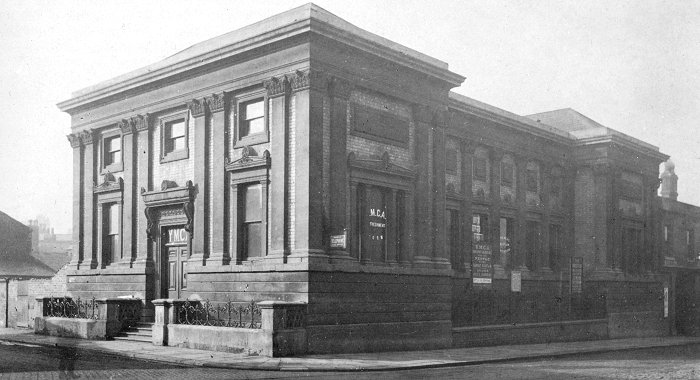|
Wolverhampton was at the forefront
of the movement to establish schools of art and design,
and opened a small school of art and design in Castle
Street, towards the end of 1851.
The art master was Mr. H.
Chittenden, and the honorary secretary was Mr. Charles
Benjamin Mander. The classes were in drawing and
designing. They became extremely popular, and led to the
raising of subscriptions for a much larger,
purpose-built building.
Wolverhampton’s New
School of Art
Land was acquired in Darlington
Street, on the corner of Art Street, for the new
Government School of Practical Art, a handsome
Greek-style, stone-fronted building, the first
purpose-built school of art in the country. The
foundation stone was laid by Lord Hatherton on the 21st
June, 1853. The building, designed by Edward Banks, and
built by John Elliot, was completed at a cost of about
£2,300. After the stone laying, a luncheon was provided
for around 300 guests in the Exchange, under the
chairmanship of the mayor, Jeremiah Wynn.
The opening ceremony took place on
the 1st August, 1854, not long after the start of the
Crimean War. Earl Granville who presided, was
supported by Lord Dartmouth, Lord Lyttelton, Lord
Hatherton, Thomas Thorley, M.P., John Neve (mayor), Rev.
J. B. Owen, Rev. William Bevan, George Briscoe, William
Tarratt, John Shaw, George Wallis, H. Chittenden, and
Charles Benjamin Mander. Lord Hatherton was elected,
first president of the school.

The new art school was
called the School of Practical Art for
Wolverhampton and South Staffordshire.
Courtesy of David Parsons. |
Shortly after the official opening,
Henry Loveridge became chairman, and Charles Benjamin
Mander became honorary secretary. Mr. H. Chittenden soon
retired as headmaster, and was replaced by Mr. J. W.
Muckley, who was later replaced by Mr. Archibald Gunn.
|

The School of Art in
Darlington Street. Courtesy of Steve Martin. |
The north façade faced Darlington
Street, and the entrance was in Art Street on the
eastern side of the building. The entrance led into the
foyer and the staircase. On one side was an 18 feet by
14 feet committee room, with an identical room on the
other side for the headmaster. Beyond the foyer was the
elementary room, 43 feet by 26 feet, followed by the
modelling room, 39 feet by 18 feet. There were also
toilets and cloak rooms. The library, the painting room,
and the antique room were on the first floor, all lit by
skylights. The porter’s flat was in the basement.
The principal staff are listed in
Harrison, Harrod, & Company’s 1861 Directory and
Gazetteer as follows:
President,
Lord Lyttleton; Vice Presidents, George Briscoe, and
Charles Corser; Treasurer and Honorary Secretary,
Charles Benjamin Mander; Headmaster, J. W. Muckley;
Second Master, Edward R. Taylor; School Warden and
Collector, Augustus Ovey.
The classes were well attended, and
the original subscribers continued to support the
school, but within a few years the school began to
struggle financially. The management committee felt that
such an undertaking, which was open to all who chose to
use it, should no longer be a burden on the small number
of subscribers. It should be under the control of the
Corporation, and supported by the local ratepayers. They
felt that if the Free Libraries Act of 1850 was adopted,
a rate might be levied for a free library, and school of
art. In 1860, Councillor Charles Benjamin Mander moved a
resolution at a meeting of the town council, to this
effect, which was accepted. Unfortunately at a
subsequent meeting of ratepayers under the chairmanship
of the mayor, the resolution was violently opposed and
rejected, after a noisy demonstration.

The side and back of
the school, as seen from Art Street. The
main entrance is behind the telephone box.
Courtesy of Steve Martin. |
Undaunted, the school managed to
keep going. In 1873 there were 178 students receiving
instruction in art and science. Seven of them gained
Queen’s prizes, eleven gained second class certificates, and a large
number obtained certificates of merit. By this time Mr.
T. Vincent Jackson had been appointed as honorary
secretary of the school.
In 1883 when building work on the
new art gallery in Lichfield Street was underway, the
school’s management committee decided to sell the school
building, and to use the proceeds to move the school
into new premises that would adjoin the art gallery. The
building was then offered for sale.

A final view of the School of Art
in Darlington Street. |